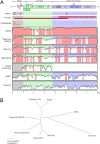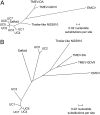Identification of cardioviruses related to Theiler's murine encephalomyelitis virus in human infections
- PMID: 18768820
- PMCID: PMC2528868
- DOI: 10.1073/pnas.0805968105
Identification of cardioviruses related to Theiler's murine encephalomyelitis virus in human infections
Abstract
Cardioviruses comprise a genus of picornaviruses that cause severe illnesses in rodents, but little is known about the prevalence, diversity, or spectrum of disease of such agents among humans. A single cardiovirus isolate, Saffold virus, was cultured in 1981 in stool from an infant with fever. Here, we describe the identification of a group of human cardioviruses that have been cloned directly from patient specimens, the first of which was detected using a pan-viral microarray in respiratory secretions from a child with influenza-like illness. Phylogenetic analysis of the nearly complete viral genome (7961 bp) revealed that this virus belongs to the Theiler's murine encephalomyelitis virus (TMEV) subgroup of cardioviruses and is most closely related to Saffold virus. Subsequent screening by RT-PCR of 719 additional respiratory specimens [637 (89%) from patients with acute respiratory illness] and 400 cerebrospinal fluid specimens from patients with neurological disease (aseptic meningitis, encephalitis, and multiple sclerosis) revealed no evidence of cardiovirus infection. However, screening of 751 stool specimens from 498 individuals in a gastroenteritis cohort resulted in the detection of 6 additional cardioviruses (1.2%). Although all 8 human cardioviruses (including Saffold virus) clustered together by phylogenetic analysis, significant sequence diversity was observed in the VP1 gene (66.9%-100% pairwise amino acid identities). These findings suggest that there exists a diverse group of novel human Theiler's murine encephalomyelitis virus-like cardioviruses that hitherto have gone largely undetected, are found primarily in the gastrointestinal tract, can be shed asymptomatically, and have potential links to enteric and extraintestinal disease.
Conflict of interest statement
The authors declare no conflict of interest.
Figures


References
-
- Brahic M, Bureau JF, Michiels T. The genetics of the persistent infection and demyelinating disease caused by Theiler's virus. Annu Rev Microbiol. 2005;59:279–298. - PubMed
-
- Ohsawa K, Watanabe Y, Miyata H, Sato H. Genetic analysis of a Theiler-like virus isolated from rats. Comp Med. 2003;53:191–196. - PubMed
-
- Pritchard AE, Strom T, Lipton HL. Nucleotide sequence identifies Vilyuisk virus as a divergent Theiler's virus. Virology. 1992;191:469–472. - PubMed
Publication types
MeSH terms
Substances
Grants and funding
LinkOut - more resources
Full Text Sources
Other Literature Sources
Molecular Biology Databases

